|
DRAVIDIAN
TEMPLE ARCHITECTURE
|

"The following works of art ...are among the most
remarkable contributions of the Tamil creative genius to the world's
cultural treasure and should be familiar to the whole world and admired
and beloved by all in the same way as ... the cathedrals of France and
the sculptures of Greece ......
Dravidian temple architecture, of which the
chief representatives are perhaps the temples of
Tanjore,
Chidambaram and
Madurai....."
Tamil
Contribution to World Civilisation - Czech Professor Dr. Kamil
Zvelebil in Tamil Culture - Vol. V, No. 4. October, 1956 "...The plan of a temple closely resembles the plan of
a human body in which the Sanctum Sanctorum (garbha gudi) is the head
and the outer gate is the lower limb. The spine (gopuram) on the outer
gate is the foot of the Lord. Even if a visitor does not enter the
temple, he can as well contemplate on the gopuram and derive the benefit
of a darshan. Temple architecture developed in two streams, Saiva style
and Vaishnava style. Silpa is the architecture and Agama is the mode of
worship. Agama of the Saivas is different from that of the Vaishnavas.
The Vaishnava worship is again in two different styles, the Vaikasana
and the Pancharatra. .."
Architecture of a Hindu Temple - Sthapathi
|
 From T.V.Mahalingam, Professor of Ancient History and
Archaeology, University of Madras on
Tamil
Art & Architecture paper presented at
Second International Conference Seminar of Tamil Studies,
January 1968
From T.V.Mahalingam, Professor of Ancient History and
Archaeology, University of Madras on
Tamil
Art & Architecture paper presented at
Second International Conference Seminar of Tamil Studies,
January 1968
"Before sketching in outline the evolution of
architecture it is necessary to acquaint ourselves with the
major types of extant structures. These basic shapes are
fivefold, viz., square (caturasra), rectangular (ayatasra),
elliptical (vrittayata), circular (vritta) and octagonal
(astasra). Generally speaking the plan of the temple was
conditioned by the nature of the consecrated deity. The
shrine of the reclining Ranganatha, for example, can only be
rectangular. The basic shapes are amply reflected in the
superstructure of the vimas . Though square and rectangular
shrines are frequently met with, circular and octagonal
shapes are very rare. However these forms are represented in
the sikhara of the vimana. The apsidal form, a derivative
from Buddhist architecture, was popular up to the 10th
century in the
Tondaimandalam, after which it declined in usage.
Mention should also be made here of the temples which
have more than one shrine in the vertical order. This is to
be found in a handful of Vaisnava temples as those at
Kanchipuram,
Uttiramerur, Madurai, Tirukkostiyur etc. Three shrines,
one above the other, are found in these and are intended for
the seated, standing and reclining forms of Visnu.
Unlike other parts of India the architectural history of
the Tamil country starts only with the beginning of the
seventh century A.D., the monuments built before that period
having perished. In early Tamil literature we hear of such
structures as koyil, maddam, nagaram, palli, pali. etc.,
which are apparently references to temples or religious
edifices. Presumably they were built of impermanent
materials which have succumbed to the ravages of time.
The earliest extant monuments in the Tamil country are
the rock-cut caves scooped out under the Pallavas, and
following them by the Pandyas, Muttaraiyars, and Atiyas. In
his inscription in the cave of Laksitayatana at
Mandagappattu, South Arcot district, Mahendravarman I
(610-630 A.D.) declares that he caused the construction of
the temple for Siva, Visnu and Brahma without the use of
conventional building materials like brick, timber, metal
and mortar; and the tenor of the language has been taken to
indicate that the king was introducing a new mode of
architecture by scooping out the cave.
Many other cave temples are definitely attributable to
Mahendravarman on the authority of his inscriptions in them.
These include the excavations at Pallavaram, Mahendravadi,
Mamandur, Tiruchirapalli, Slyamangalam and Dalavanur. The
Vasantesvaram at Vallam was also excavated in
Mahendravaraman's reign by a feudatory of his.
Besides these caves of definite authorship, those at
Kuranganilmuttam, Vilappakkam, Aragandanallur and the
Rudravahsvara cave at Mamandur are stylistically
attributable to the period of Mahendravarman. These caves of
Mahendra are simple in plan and consist of a mandapa with
one or a few shrines. The sculptural decoration of the caves
is inconspicuous. The pillars in them are equidistant and
have square sections both on base and top with the portion
in between chamfered octagonally. In the square section are
seen delicate carvings of lotus medallions. The pillars and
pilasters carry on top massive corbels with beams.
This 'Mahendra style' was continued by his son and
successor Mamalla, the famous Narasimhavarman I, who,
however, introduced certain variations in some of his caves.
In these the entablature is almost completely finished,
unlike in those of the Mahendra variety. Besides kudu arches
in the cornice, it carries salas, karnakutas and
alpanasikas. The pillars in Mamalla's caves are not only
taller but also more slender than those of his father. The
strutting figure of a lion ro vyala as the base of the
pillar is a notable feature. Again in Mamalla's caves one
can also find large bas-reliefs on walls in striking
contrast to their plain nature in all but one of Mahendra's
caves. The Konerimandapam, Varahamandapam,
Mahisamardanimandapam, Trimurti cave, Adivaraha cave,
Ramanujamand. apam, etc. - all at Mahabalipuram - are
typical examples of the Mamalla types of rock architecture.
The Pandyas, who were ruling in the extreme south of the
Tamil country, appear to have soon adopted the rock-cut
technique and developed certain interesting variations in
their excavations. It is possible that the cave at
Pillaiyarpatti is one of the earliest Pandya attempts in the
rock medium as evidenced by the archaic palaegraphy of the
inscription in Vatteluttu characters in it. The Siva cave
shrine at Malaiyadikurichi is assignable on the basis of an
inscription to the second half of the seventh century and
the Narasimha cave at Anamalai and the Subrahmanya cave at
Tirupparankunram are on the same ground datable respectively
to 770 to 773 A.D.
At Tiruttangal, Piranmalai, Kudumiyamalai and
Sittannavasal are to be found other caves of the Pandyas.
Though similar to Pallava caves in plan and design, the
Pandya examples differ from them in their adoption of
certain Calukyan features such as the introduction of the
rock-cut linga and Nandi and sculptural representations of
Ganesa and Saptamatrkas. The pillars are large and
reminiscent of those of the Mahendra variety with corbels
generally with a plain level.
In this movement of scooping out live rocks for divine
abodes minor dynasties like the Atiyas and Muttaraiyars also
participated, though stylistically their excavations are
much akin to those of their political master. The cave at
Namakkal is evidently an Atiya enterprise while Muttaraiya
involvement may be seen at Tiruvellarai,
Narttamalai, Kunrlandarkoil etc.
Under Narasimhavarma I, Pallava rock-architecture took a
new turn. besides cutting into rocks for caves, attempts
were made to cut out monoliths from rocks. The rudiments of
this practice are to be found in the carved-out stupas in
the caves of Western India and the vimana-form in the Tawa
cave at Udayagiri but it was at
Mahabalipuram
under the Pallavas that it found a full and eloquent
expression.
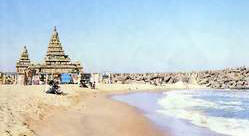 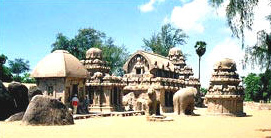
Architecturally they depict the external aspects of
contemporary brick and timber structures. There are as many
as nine monoliths at Mahabalipuram of which the five, named
after the Pandavas and Draupadi, are a well-known assemblage
of contiguous excavations, the other examples are the Ganesa
ratha, Valayankuttai ratha and the two Pidari rathas. As
they represent varying architectural designs they are of
primary importance for any study of the plan and different
zones and the details of the Yima-nas.
The
Dharmaraja-ratha is three-storeyed with a square viguana
and an octagonal dome. Though the
Arjunaratha is similar to this it is two-storeyed. The
Bhimaratha has a wagon-top roof and is single-storeyed
unlike the Ganesa ratha, another example of wagon top roof,
which is double-storeyed. The
Draupadiratha
is hut-shaped and is square in plan and its roof is domical.
The
Sahadevaratha represents the apsidal form with its back
resembling that of an elephant, a feature high-lighted by
the carving of a huge elephant by the side of the monolith.
The only non-Pallava monolith in the Tamil country is
Kalugumalai which was cut-out under the Pandyas. This has
been cut out, like the Rastrakuta monoliths in the Deccan,
by entrenching all round and not by free cutting of standing
rocks as in the Pallava domain.
Though the rock medium appears to have continued for some
more time it was soon replaced by structural temples. This
movement, as available evidences indicate, appears to have
first started under Narasimhavarman I's grand-son
Paramesvaravarman (669-691 A.D.), though it is not unlikely
that the practice was still older. A few pillars in the
typical Mahendra style, one of them with an inscription of
Mahendravarman I, found in the Eltamranatha temple at
Kanchipuram
seem to suggest that even at the beginning of the seventh
century structural mandapas were built. The presence of
Pallava pillars at Sivanvayil, Kuram, Vayalur, Tirupporur
etc., is enough to confirm this.
The Vidyavimta Pallavesvaragriha at Kuram built by
Paramesvaravarman I is an early structural edifice. The
provision of a series of vertical and horizontal slabs
instead of a full bAitti is an interesting and early feature
in this temple. While this is a small temple and reflects
the modest nature of the enterprise, the temples of the next
reign are large in size, elaborate in plan and rich in
architectural and sculptural decorations. With the accession
of Narasimhavarman II Rajasimha the history of Pallava
architecture enters upon a new and eventful phase.
While the temples of
Kailasanatha at
Kanchipuram, Talagirlsvara at Panamalai and the
Shore temple
at Mahabalipuram are indisputably assignable to his
reign on epigraphical grounds, a large number of other
smaller temples are also stylistically akin to them. The
temples of Vaikuntanatha, Muktesvara and Matangesvara at
Kanchipuram
are said to be slightly later and belong to the reign of
Nandivarman Pallavamalla.
The Kailasanatha is four-storeyed and is an example of
sandharaprasada containing two walls providing an
ambulatory.
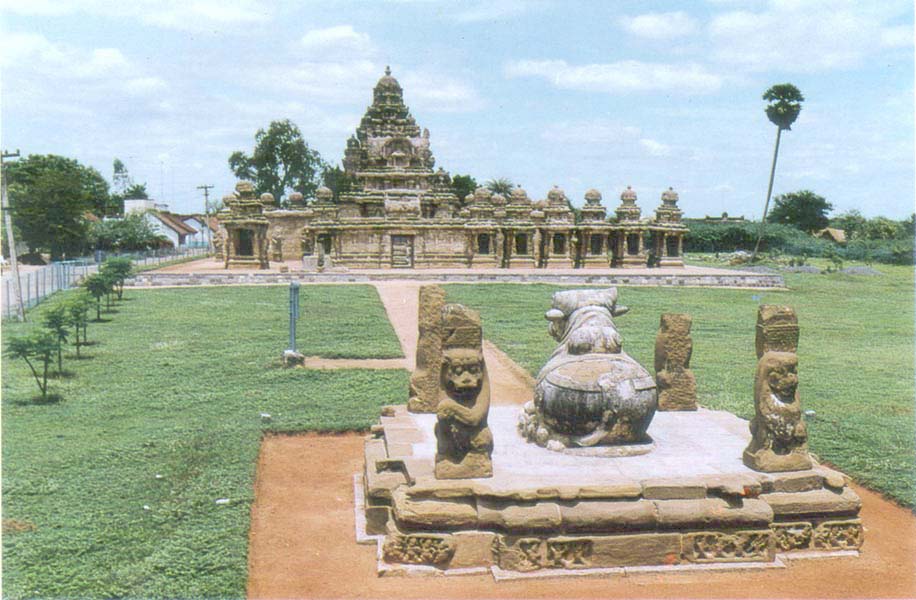
The storeys are decorated with architectural designs like kutas, kostas and
panjaras. The pillars in structural temples are with rampant lions generally and
with elephants, nagas and bhulas at times. Niches are to be seen in both the
rock-cut and structural temples and have a makaratorana decoration on their top,
the makaras in them having floriated tails overflowing on the sides. The corbels
are generally curved in profile with the taranga (wave moulding) ornament and a
median band. The gopuras are absent in these early temples.
In the
Kailasanatha at Kanchi and the
Shore Temple
at Mahabalipuram there are faint but unmistakable
suggestions of gopuradhvaras which were to evolve into
towers. Another feature of these early structural temples is
the almost prodigal sculptural embellishment of the exterior
walls. The carvings are invariably those of deities, a few
of which appear to be fresh inceptions from the Calukyan
area.
The Colas who supplanted the Pallavas about the middle of
the ninth century as a political force continued the
latter's artistic activities. For about five centuries a
large part of the Tamil country besides peripheral regions
in contiguous areas in Andhra, Karnataka and Kerala were
under their sway which they studded with hundreds of
temples. On the basis of certain accepted notions regarding
the evolution of temple architecture and on the authority of
numerous inscriptions it is now fairly possible to determine
the dates of most of the Chola monuments. Though the
periodisation of South Indian art-history is even now a
subject of debate it is conceded by most scholars that the
Chola temples are broadly divisible into three groups:
the first group belonging to the period from the
accession of Vijayalaya to the accession of Rajaraja I
(i.e., 850-985 A.D.);
the second group assignable to the period from the
accession of Rajaraja I to the accession of Kulottunga
(985-1070 A.D.); and
the third group comprising the period from the
accession of Kulottunga I to the decline and fall of the
Chola empire under Rajaraja III and Rajendra III
(1070-1270 A.D .).
The temples of the first group are many which in
stylistic characteristics break away from the structural
temples of the Pallavas. In the Pallava temples the
lowermost tier of the vimana is extended to the vestibule in
front of the shrine, while this is not found in early Chola
temples, the only exception being the
Vijayalayacolisvaram at Narttamalai

[see also
Takeo Kamiya - Architecture of the Indian Sub Continent] which according to
recent researches is not a Chola but a Muttaraiya edifice. The torus moulding in
the basement which is chamfered in Pallava temples continues to be so in the
Chola period for sometime but soon gets a rounded shape. The cornice in Chola
temples is no longer a projecting tier as it is in Pallava monuments but gets a
flexed shape. The old lion and vyala motifs in pillars are also dispensed with,
though they linger for sometime in a few temples. Further, the corbels in
pillars get an angular profile and are bevelled, resulting in a triangular,
tenon-like projection. The absence of extravagant sculptural decoration on the
exterior of the shrine walls is another distinguishing feature.
Though typical early Chola examples are numerous, special
mention must be made of those at Kilaiyur,
Srinivasanallur
(Koranganatha),
Kumbhakonam, Erumbur, Pullamangai, Punjai and
Kodumbalur. The introduction of sub shrines for attendant
divinities (parivara-devatas) noticed in these temples
reveals elaboration and development of the temple complex.
In fact the beginnings of this practice are to be
discerned even in the latter Pallava temple of
Virattanesvara at Tiruttani built under Aparajita. This
temple, though Pallava in name, is Chola in design and style
and chronologically almost coeval with some of the Chola
monuments enumerated above. The parivdra shrines, usually
eight in number, were meant for attendant deities like
Ganesa, Subrahmartya, Surya, Candra, Saptamatrkas, Jyestha,
Candikesvara and Nandi. The gopuras of this period continue
to be inconspicuous, the vim�nas, dominating the temple
complex.
Generally speaking, temples built under Aditya and
Par�ntaka contained only three niches in the shrine walls,
one on each wall, and two niches in the walls of the
ardhamandapa, again one on each wall. While the niches in
the southern and northern walls of the ardhamandapa carried
respectively carvings of Ganesha and Durga, those of the
main shrine were intended for Daksin�murti and Brahm�. The
niche in the rear wall offered scope for variation, the
enshrined deity being either Lingodhbhava or Visnu, Harihara
or Ardhan�risvara.
But even in two very early temples - those at
Srinivasanallur and Kumbhakonam - the tendency to multiply
the niches is found, the additional niches carrying what
looks like portraits. This tendency has been developed in
the temples built by Sembiyan Mahadevi, mother of Uttamacola
at such places as Tirukkodikk�val, Sembiyan Mah�devi,
Anangur, Aduturai, Tirunaraiyur, Kutt�lam, etc., where the
additional niches carry such iconographic types as Natar�ja,
Bhiks�tana and Ardhanri besides Agastya.
These early Chola architectural traditions are carried to
those of the later Chola period by the temples built under
the illustrious Rajaraja and his son R�j�ndra. Many are the
extant examples assignable to this middle phase, the most
famous among them being the
Brihadisvara temple
at Tanjore and
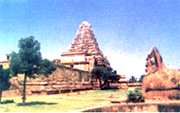 Gangaikondacolapuram. Gangaikondacolapuram.
Other temples of this period are those at Tiruvaji, M�lpadi, Tiruvala�juli,
Tirumalavadi, Tiruvarangulam, Dadapuram, etc. In most of these temples the
basement is ornamented with pilasters which carry a cornice. The walls have a
greater number of niches and a semi-circular arch (tiruvacci) the centre of
which is identical with that of� the k�du which appears beneath the architrave
and over the niche. The introduction of the kumbhapa�jara in between the niches
is another feature.
The Tanjore temple
is undoubtedly the grandest achievement of the age.
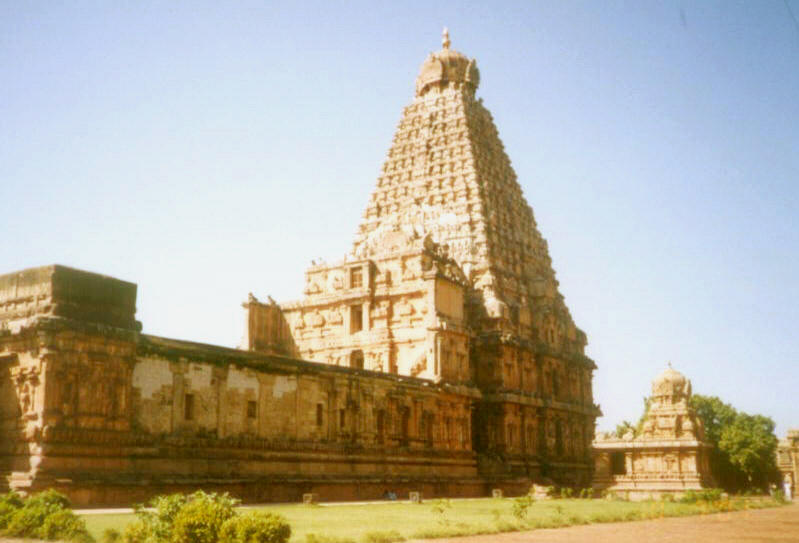
It was more a monument of triumph than a strict example of
temple architecture. It is in this temple that one notices
for the first time two gopuras oriented in the same
direction. They are architecturally coeval with the main
vimana and are referred to in inscriptions as Rajar�jan
tiruvasal and Keral�ntakan tiruvasal In spite of the massive
size of the gopuras the vim�na, rising majestically to a
height of 190 feet, continues to dominate and it is only in
the subsequent period that a change in the gradation of
magnitude takes place.
The multiplication of pariv�ra shrines and the
introduction of a separate shrine for the goddess are the
two significant changes in the temple complex effected
during this period. Even in the Tanjore temple the Devi
shrine is not contemporaneous with the main cella but was
built later. The earliest Devi shrine which appears to be
definitely chronologically coeval with the main shrine is
the one at Gangaikondacolapuram.
The Devi shrines, known as Tirukkdmakkottams, were thus
largely a feature from the reign of R�j�ndra. In the temples
representing the final phase of Chola architecture a
discernible maturity of style is evident.
Notable examples of them are to be found at D�r�suram,
Tribhuvanam,
Chidambaram
and Jambukesvaram. Of the stylistic improvements made in
these temples mention must be made of the torus moulding in
the basement which is rounded and has a smooth surface,
though in a few cases it is orna�mented with vertical
grooves or ribs. The makaratoranas become tall with narrow
reverse curves on each side; the kumbhapanjaras are also
developed and carry on top over the abacus the
superstructure of a panjara. The phalaka in the pillars are
thinner than those of earlier periods and the padma below
it, which is inverted and smooth in early temples, now has
petals. The pillars in the mandapas have attached pilasters
on their sides, known as Aniyottikal.
Perhaps the most distinguishing feature of the temples of
the late Chola phase is the increased height of the gopuras.
The five-storeyed gopuras at Tiruvenk�du,
Uyyakondan-Tirumalai, Tirucceng�tt�ngudi and Kumbhakonam
must belong to this phase. Besides the gopura, pillared
mandapas were also built within the temple complex, some of
them being shaped in the form of a chariot by the addition
of wheels and horses and elephants.
Generally speaking, the characteristics of the early and
late Chola temples are shared by Pandya monuments of the
respective periods, though minor variations are present in
them.
The next stage of development is, however, seen only in
the temples built under the Vijayanagar rulers. The
Vijayanagar kings not only built many new edifices, but made
many additions to the already existing temples. Such
additions are to be found in many places, the most
noteworthy among them being
Kanchipuram,
Tiruvann�malai,
Chidambaram,
Kumbhakonam,
Madurai,
Srirangam,
Vellore, etc.
The mandapas become large and conspicuous adjuncts during
this period due to the multiplication and elaboration of
religious rituals and ceremonial observances. The
Kaly�namandapa, Sop�natmandapa, Davana�mandapa,
Sndpanamandapa, Ala�k�ramandapa, etc., are the usual
mandapas in addition to the ardha, mukha and mah� mandapas
of earlier times.
Some of these mandapas are, however, not entirely unknown
under the late Colas. A few of them were built outside the
temple circuit but not much away from it. These mandapas are
essentially pillared halls, open or closed, and contain
either a shrine or a raised platform over a huge tortoise
either in the centre or behind. They are also notable for
their pillars which are rich in sculptural work and to which
are attached riders on horse or lion or y�li. The fluted
type of simple pillars becomes rare and huge and monolithic
ones are often seen. They have ornamental brackets forming
their capitals, below each of which is a pendant. This
pendant has been in many examples elaborated into a �volute
which terminates as an inverted lotus bud.�
The niches in the walls are not surmounted by tor�nas as
in Pallava and Chola temples but have a simple pa�jara
design over them. What is more, the niches are empty,
without any image in them. Their old functional character
has been lost and they remain a simple ornamental design on
the exterior of the wall. The increase in the height of the
gopuras and in the number of pr�karas is yet another
feature. The gopuras are generally seven�storeyed and are
large and tall, especially in the Pandya region. The most
typical gopuras of this period are to be found at
Ka�chipuram,
Srirangam,
Chidambaram
and
Tiruvannamalai.
These are rich with architectural designs like salas,
karnakutas and alpanasikas rather than sculptural
decoration.
The Vijayanagar mode of architecture was continued by the
Nayak rulers of Madurai. In the temples renovated or rebuilt
by them, as the ones at
Madurai,
R�mesvaram
and Tirunelveli, the corbels in the pillars show at their
ends a plantain-flower-like motif. The gopuras continue to
be slender and tall, the typical example being the
Vatapatrasayi gopura at
Srivilliputtur which is eleven-storeyed. The corridors
in these temples, unlike those of earlier periods, are
provided with ceilings which are at times painted.
|